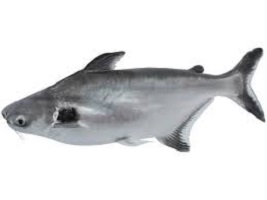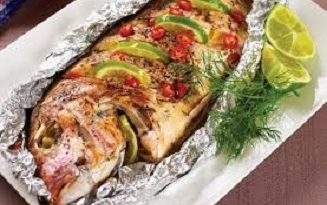Swai Fish: to Eat or Not to Eat? Clean or Unclean
Swai Fish: Should You Eat or Not Eat It? Clean or Unclean

Swai fish is a Southeast Asian delicacy with a gentle, sweet flavor and luscious flesh. Its soft and flaky texture makes it a favorite element in a variety of delectable meals.
Swai fish is high in omega-3 fatty acids and protein. These healthy fats help improve the health of your heart and brain.
However, there have been safety concerns raised about swai fish farming procedures. Is it nutritious and safe to eat?
The advantages, nutritional profile, health risks linked with the fish, and environmental impact of swai fish farming are discussed in this article.
The Swai Fish, formally known as Pangasianodon hypophthalmus, has grown in popularity in the United States over the previous few decades.
It is a freshwater fish that is native to Southeast Asia’s Mekong Lake, although it is farmed extensively in Vietnam. The majority of swai fish available comes from Vietnam.
Swai fish is called by several names that include
- Vietnamese catfish
- Panga
- Pangasius
- Striped catfish
- Basa
- Iridescent shark
- Tra
- Sutchi
- Cream dory
- Silver striped catfish
- Vietnamese river cobbler
Swai fish is popular among American families since it lacks the traditional fishy flavor and odor.
It is flavorful and absorbs the flavor of any dressings or sauces applied to it. It is even less expensive than the majority of other fish.
It’s perfect for broiling, grilling, or frying because it’s a meaty fish with a less skeletal structure.
Because of these factors, it has become one of the most popular dishes in restaurants in the United States.
However, reports of improper fish farming procedures in Vietnam raised questions about its safety.
Swai fish is both inexpensive and delicious.
It’s usually imported from Vietnam and has grown in popularity in the United States over the past couple of decades.
Many people who eat swai, on the other hand, may be unaware of the issues surrounding its production on overcrowded fish farms.
This article will offer you information about swai fish so you can decide whether to eat it or avoid it.
Table of Contents
An Overview
Swai is a juicy, white-fleshed fish with a firm texture and a bland flavor. As a result, it readily absorbs the flavors of other substances.
Swai is the sixth most popular fish in the United States, according to the National Oceanic and Atmospheric Administration (NOAA).
It comes from the Mekong River in Asia. Consumer swai, on the other hand, is most typically produced on Vietnamese fish farms.
Indeed, swai production in Vietnam’s Mekong Delta is one of the world’s largest freshwater fish farming industries.
Swai was once known in the United States as Asian catfish. Only fish in the Ictaluridae family, which includes American catfish but not swai, can be classified or sold as catfish, according to a law issued by the US Food and Drug Administration (FDA) in 2003.
Swai belongs to a different but related Pangasiidae family, and its scientific name is Pangasius hypophthalmus.
Nutrition Facts
According to the USDA, one 4-ounce fillet of swai provides about:
- 70 calories
- 350 milligrams sodium (varies)
- 45 milligrams cholesterol
- 15 grams protein
- 5 grams fat
Swai (or pangasius) has 17 mg of EPA and DHA per 100 grams of fish, according to Purdue University research.
The ingredients you use to cook and coat swai fillets will, of course, alter the nutritional value, often adding more fats, carbohydrates, and sodium.
Is Swai Fish Safe to Eat? Clean or Unclean? Healthy or Not? To Eat or Avoid?
Let’s have a look at some of the research findings that may help you decide whether or not to consume swai fish.
Speculation about the presence of high levels of mercury:
Several investigations from reputable international organizations have highlighted the poor quality of the water in which swai fish are bred. Heavy metals, such as mercury, have been identified in swai fish in concentrations that are above the permitted range for consumption, according to research.
Vietnam’s unsafe fish farming practices
Swai fish isn’t picky when it comes to what they eat.
As a result, they have been given restaurant leftovers or low-cost, high-quality fish meals in Vietnam.
The swai fish may become poisonous and of poor quality as a result of this.
Increased antibiotic administration
Another source of worry is the overuse of antibiotics in swai fish. Many swai fishes have evolved resistance to a few antibiotics that are also used to treat illnesses in humans, according to reports.
As a result, humans who ingest such swai fish are at an elevated risk of developing antibiotic resistance.
Antibiotic usage in marine life is governed by strict rules and regulations in the United States, and certain antibiotics have been banned in fish aquaculture. Unfortunately, there is no such regulation in Vietnam.
High sodium content
The sodium level of swai fish from Vietnam was found to be high (222-594 mg/100 g), most likely owing to sodium tripolyphosphate (used to retain moisture).
The high sodium content can cause problems like high blood pressure.
Any Potential Benefits?
If you like swai, acquire it from a reputable firm that sells environmentally safe items.
Choose a product that has been certified by an eco-certification program. ASC Farmed Pangasius, Naturland, and BAP Certified are some of the labels to search for.
If you can’t find a swai product with these types of certificates, a healthier fish option with even more omega-3 fatty acids, such as wild-caught salmon, is a better choice
Healthier Fish Alternatives
Swai isn’t the only fish that could be harmful to your health. So, what options does that leave pescatarian lovers with? Plenty
Here’s a rundown of some healthy fish choices:
Salmon: Wild-caught Alaskan salmon is high in vitamins B12 and D, both of which are lacking in many Americans.
Salmon is also an excellent source of nutrients for the brain. It will prevent brain fog and improve memory because it contains so many omega-3 fatty acids.
Try this Blackened Salmon Recipe with Anti-Inflammatory Spices and Massaged Kale to add salmon to your diet. This Teriyaki Baked Salmon Recipe is extremely quick and easy to make.
Sardines
Collected in the Pacific is another nutritious option that’s easy to find and use in recipes — and they’re also cheap.
Sardines do not face the same sustainability challenges as other fish because they are so low in the food chain.
They actually reduce inflammation and promote bone health, which is rather impressive for such a small fish.
Atlantic Mackerel
Mackerel fish has nutritional value comparable to wild-caught salmon. It’s packed in protein, omega-3 fatty acids, and micronutrients.
It’s also thought to help with blood pressure and bone strength.
Albacore Tuna
Fresh, wild-caught albacore tuna is high in antioxidants, and protein, and may even help to improve brain function.
Instead of canned tuna, opt for tuna steak to prevent higher salt levels. This Tuna Pasta Salad with Kalamata Olives and Cherry Tomatoes is a must-try.
Fish oil supplements
You may obtain the omega-3 advantages of fish without eating it if you take a good phytoplankton supplement.
The abundance of omega-3s EPA and DHA saw in some fish is due to the fish’s consumption of phytoplankton.
The Bottom Line
While there is research on pangasius fish, especially when compared to more popular fish like tilapia and salmon, what we do know is enough to pose some serious concerns.
Only part of the problem is the likelihood of pangasius fish being sold with antibiotic residues and lower standards.
There’s also the reality that practically all pangasius sold in the United States comes from factory farms.
Instead of cheap pangasius, choose fish like wild-caught salmon and Pacific sardines, which are low in pollutants and high in omega-3 fatty acids.
FAQs
How to Cook Swai Fish ~ Swai Fish Recipe
The most important thing to remember when cooking pangasius is that its quality may not be as good as other fish on the market, so cook it thoroughly.
You shouldn’t eat it raw, rare, or medium-rare, but you can fry, bake, grill, or steam it like any other white fish.
It can be battered and deep-fried without coming apart, and it can withstand the heat of an open flame.
Swai’s flesh is a pale beige tint that turns creamy white when cooked. Swai absorbs tastes effectively, making it a fantastic match for rich sauces and marinades, especially those with citrus flavors.
What Does Swai Fish Taste Like?
This light fish is best described as mild with a tinge of sweetness. Swai’s flesh is soft and flaky once cooked, making it more palatable to the palette than its relative, catfish.
In terms of flavor, it’s similar to catfish, but the pangasius fish is more delicate in both flavor and texture.
Swai Fish vs. Tilapia
Pangasius and tilapia are both freshwater fish that are less expensive than many other varieties of fish, owing to their ease of farming.
Pangasius is a Southeast Asian fish that is frozen and exported to the United States, whereas tilapia is harvested and raised all over the world.
Both fish are white when cooked and become soft and flaky, making them excellent choices for fried fish cookouts.
Are Swai Fish and Catfish the Same Thing?
Pangasius and catfish are not the same things. They can, however, be used interchangeably because they have the same flaky texture and taste.
Pangasius fish has the most basic fish flavor, which may be easily replaced by other white-fleshed fish.
Is the swai fish a bottom feeder or a top feeder?
Pangasius fish is a species of shark catfish native to Vietnam. They are also known as iridescent sharks.
These bottom-feeding omnivores reside in the Mekong River and travel upwards in the late summer as the water levels rise.
Swai fish and pregnancy
Because sharks, swordfish, king mackerel, and tilefish (also known as golden bass or golden snapper) contain high levels of mercury, pregnant women should avoid eating them. The neurological system of a developing fetus gets poisoned by mercury.
Is it safe to eat swai?
Despite popular belief, Swais are safe to consume and do not have a low nutritional content. Some are just “unsafe” since they have not met country rules for producing catfish and swai meals.
To summarize, the manner some of this seafood was farmed is harmful, not the fish itself.
Why you should eat swai fish? Benefits of swai
Swai fish is well-known for its gentle and sweet flavor. Because it contains a high concentration of omega-3 fatty acids, having this fish in one’s diet can assist enhance cardiovascular health.
This fish can help reduce the risk of death from heart disease and is also high in DHA, which can help with cognitive function.
Is swai fish clean or unclean?
Unclean
Because of the variable quality of Vietnamese-imported fish, such as swai fish, they are frequently regarded as “unclean” and create a number of health issues.
The swai fish (Basa) is indigenous to Vietnam and is primarily imported into the United States.
Is swai fish healthy for the heart?
Swai fish is a Southeast Asian favorite with a gentle, sweet flavor and luscious meat. Its soft and flaky texture makes it a favorite element in a variety of delectable meals.
Swai fish is high in protein and omega-3 fatty acids. These healthy fats can improve your heart and brain health.
Which is better tilapia or swai? swai vs tilapa
Tilapia is fatter than swai and has darker spots on the flesh. Fresh tilapia can be purchased in North America, but swai is always found frozen.
There isn’t much of a difference in taste or texture, especially when the sauce is the star of the dish.
What’s the healthiest fish to eat?
6 of the Healthiest Fish to Eat
- Albacore Tuna (troll- or pole-caught, from the US or British Columbia)
- Salmon (wild-caught, Alaska)
- Freshwater Coho Salmon (farmed in tank systems, from the US)
- Oysters (farmed)
- Sardines, Pacific (wild-caught)
- Rainbow Trout (farmed)
Is swai a bottom feeder?
Swai fish, often known as iridescent sharks, is a species of shark catfish native to Vietnam.
These omnivorous bottom feeders reside in the Mekong River and travel upwards in the late summer as the water levels rise.
Iridescent sharks can grow to be as large as 100 pounds if left to their own ways.
Is swai fish useful for lowering cholesterol?
Three grams of the five grams of fat are considered heart-healthy unsaturated fats, while the remaining two grams are saturated fats.
Swai fish has 15 mg of cholesterol and 300 mg of salt per serving. This is equivalent to between 5% and 12% of the daily limit.
Is swai fish better than catfish?
Swai has a bland flavor because the meat is not as tasty as catfish, thus it absorbs the flavors of the seasonings used to make it.
As a result, some will contend that swai tastes better than catfish.
What seafood is considered unclean in the Bible?
CREATURES OF THE SEA
Sea creatures such as shrimp/prawns, lobster, scallops, mussels, oysters, squid, octopus, crabs, and other shellfish) are contaminated. Some “fin fish” do not have scales (for example, different types of tuna – blue fin and yellowfin are clean) and are thus included among the Biblical unclean foods.
What is the composition of swai fish? What is swai fish made of?
Swai fish is a mild-flavored white fish with a flaky texture. It is a species of catfish and a freshwater fish native to Vietnamese rivers.
It is also known as the Vietnamese catfish, basa fish, and iridescent shark, but it is neither a basa nor a shark.
What are the clean fish in the Bible?
Clean
- Albacore (Crevalle, Horse Mackerel)
- Alewives (Branch & River Herring)
- Anchovy
- Blueback (Glut Herring)
- Bass
- Black Drum.
- Blackfish
- Bluebill Sunfish.
What is the best fish to fry?
Here are some of the best types of fish to fry:
- Tilapia
- Catfish
- Striped Bass
- Trout
- Cod
- Perch
- Shrimp
- Halibut
Is swai fish fished in the wild?
Choose wild-caught over farm-raised.
Wild-caught swai is more likely to be free of pesticides and other issues associated with farm-raised swai.
Make sure you buy swai from a trustworthy supplier in the United States.
What does the word swai mean in English? Is swai a type of catfish?
Swai is also known as Vietnamese catfish (though it is not a catfish), iridescent shark (also not a shark), and basa (which is deceptive, since basa is actually a different species).
It’s also known as tra hypophthalmus, sutchi hypophthalmus, and pangasius hypophthalmus.
Which white fish is the healthiest to eat?
Cod.
The Cod is a British mainstay in dishes like fish and chips, but it’s also one of the healthiest white fish available.
Cod is high in protein, low in fat, and a good source of vitamin B12, which is required for energy and nervous system support and may help avoid depression.
What does swai fish taste like? Does swai fish taste fishy?
Swai becomes what people adore when it’s cooked: flakey, yet delicate and juicy.
Its meat likewise becomes white when cooked. Above all, consumers value swai for its sweet, buttery, and mild flavor, which lacks any touch of fishiness.
In fact, the flavor and texture are similar to those of popular salmon.


